
Combining the feature groups with customer journey

Grouping the contents in the feature list
UX Designer
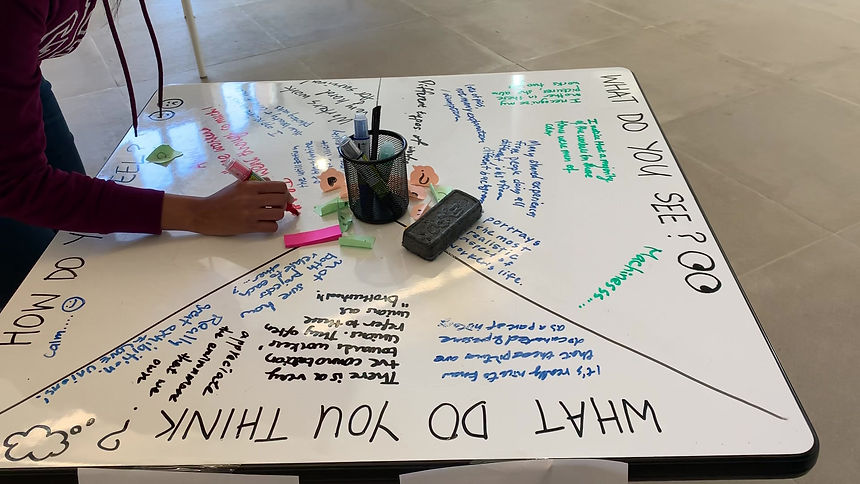
Facilitating Learning Experience in Museums
How might we improve the engagement of museum visitors with the museum content?
Project Overview.
MY ROLE
UX/ Product Designer
Investigation, Product Design, Sketching, Storyboard, Usability Testing , Prototyping
RESULT
Interactive whiteboard for museums (Overview video as shown below)
TIME SPENT
1.5 months | 2019. Oct-Nov.
TEAM
With a UX researcher, a UX Designer, and a Project Manager

Design Process.
Problem Statement.
" Overarching Problem: How might we improve the engagement of museum visitors with the museum content?"
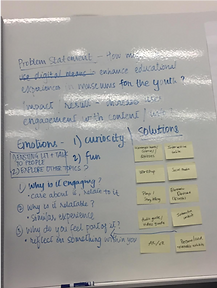
We used the 5-why method to identify the core issue and opportunity. To fill the gap between museums and visitors, we hope to change the role of visitors from observers to participants by enhancing their learning experience.
Museum's role
Traditionally: collect, preserve, and share collections
Now: A shared space for discussion that shapes communities
Visitors' need
What am I learning? How does this concept connect to something I’ve seen before?
Higher psychological needs
Investigation and Key Findings.
Most of the users are confused by the insufficient contextual knowledge
TARGET INTERVIEWEES
Visitors who have been to museums over 2 times within a year
INTERVIEWEES
7 museum visitors + 1 curator (Originally, we expected to interview 4 visitors and 4 curators. However, our team was not able to get in touch with that many curators.)
VISITOR TYPES
Type1: museum-fan (Early adopters) Type2: museum-fun
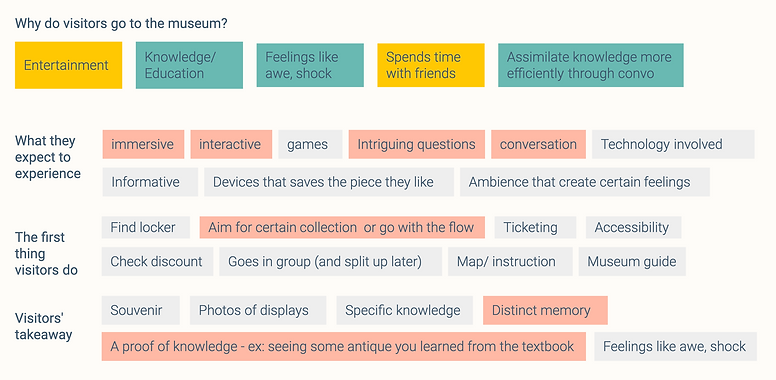

Empathizing.
Based on our research and investigation, we built two personas for museum-fan and museum-fun people. We decided to focus on the museum- fan visitors since they are our early adopters.
Persona - Opting for "Museum-Fan"
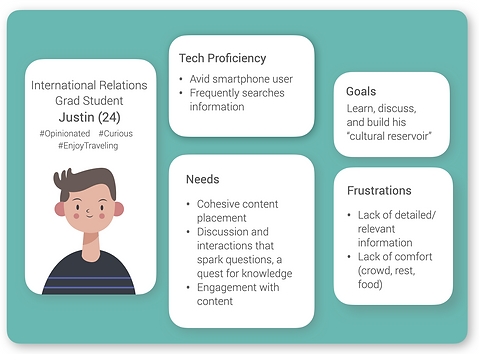
Museum Fan (Selected)
Museum Fun

Museum Fan's (Justin) Pain Point: Inconsistent Information

The User Journey Map - How Does Justin Feel?
The Original Flow
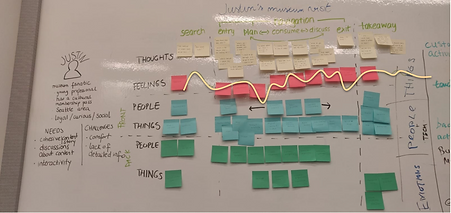
Our Expectation

We were surprised that Justin's experience flow was curvy and interrupted when encountering inconsistent context.
"Identified Opportunity: Facilitate the learning experience of museum visitors through discussion."
Brainstorming and Ideation.
METHODS
Mashup Innovation for brainstorming | COCD Box for idea selection
During the ideation, we came up with around 15 examples of technologies, human needs, and existing services in museums. We then each combined one item from each category to create new ideas, categorized them according to common themes, and rated them using the dotmocracy. In this phase, we came up with three ideas--Immersive storytelling, personalized content, and gamification.
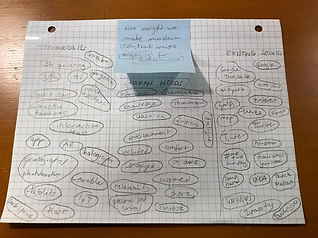
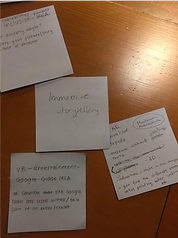


immersive storytelling
game
personalized content
Used COCD Box to Select the Most Feasible Solution
BOLDFACED
Original ideas from the brainstorming session
REGULAR
Existing ideas
We narrowed our final idea using the Centre for Development of Creative Thinking matrix (COCD box) and strategically selected the best idea based on originality and difficulty of implementation.

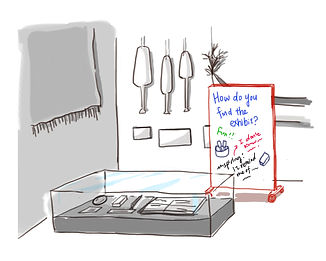
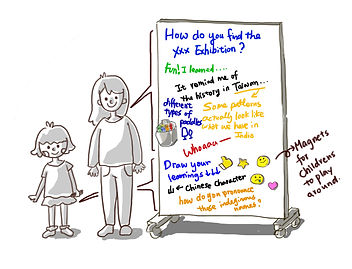
We aim to build an interactive non-digital-like platform welcoming people to play with it. And at the same time, we want to provide some conversation-based learning by posting questions.
The Initial Thoughts
Final idea - The Interactive Whiteboard.
Adjustable whiteboard-petals
Make this table accessible to both adults and children
Subtly fits into the exhibition space
Users' experience flow won't be interrupted from jumping back and forth between analog and digital contexts.
Seamless data collection
Collected user feedback can help improve the quality of future exhibitions, obtain financial aid.
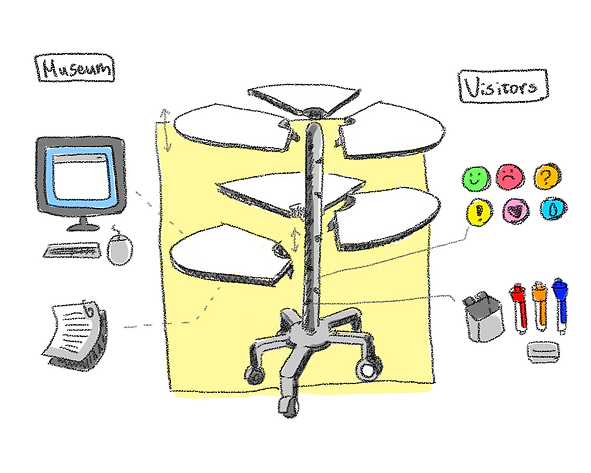
Engaging questions on the board
Harder questions can be found on the higher boards, eliciting opinions and in-depth reflection for adults.
Multi-sided
Enables people of all ages to jot down their thoughts at the same time and interact.
Choice of expression (Emoji magnets and markers)
Visitors can easily express their thoughts.
Choosing analog form over digital form
We had a debate over the prototyping form before we start prototyping. Therefore, we did a fly-on-the-wall observation at Burke museum. Surprisingly, out of 30 people, only 1 person pulled out his phone to take picture during our 1-hour observation. We then realized that human's behavior change dynamically when they are switching between analog and digital form. Therefore, we concluded that the interactive white board has to be fully analog or low-key digital.
Key Scenario
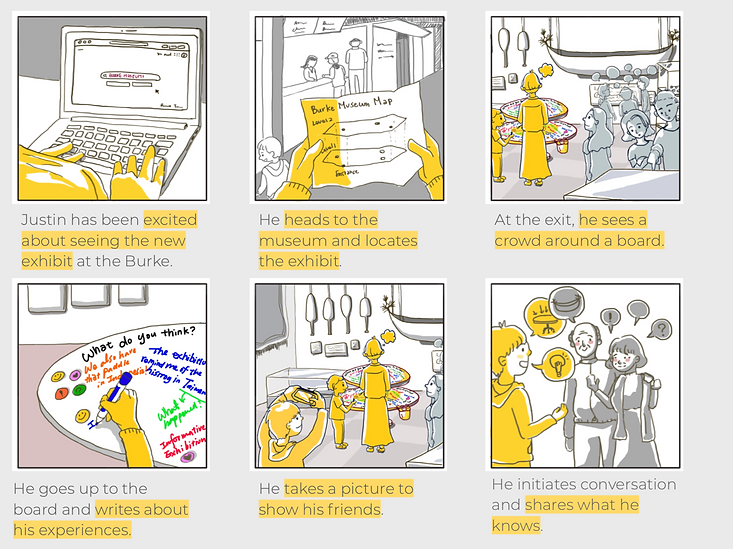
Experience Prototyping and User Testing.
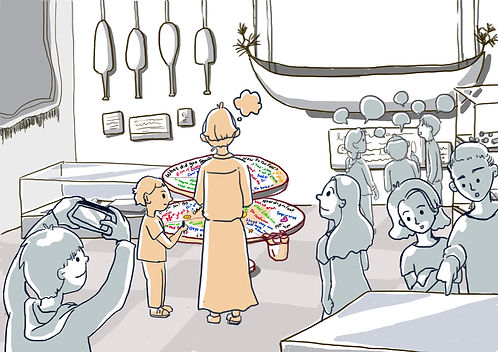
Idea Testing#1: Sketch, Storytelling, and Rapid Feedback Collection
We use this sketch to show potential users our final idea. We first shared the idea in class and went to talk to an expert in museology at the University of Washington for professional feedback.
Evaluation#1 from an Museum Expert
"I really like your idea, researches show that learning is actually conversation-based in museums."
"Your idea is also helpful for museum people. Although educating the public is one of the important missions of museums, only a few of them reach out to users before holding an exhibition."
-- Jessica, senior lecturer & director of the Museology Graduate Program at the University of Washington
Takeaways:
-
Context-based questions are helpful for users to process their thoughts
-
Collected user data will help:
-
Museum managements understand their patrons
-
Funding sources develop ideas on where their capital went
-
Staffs better assist visitors
-
-
The whiteboard also serves as a proactive evaluation tool for museums
-
Physical interaction and inquiry-based learning are preferred
Idea Testing#2: Experience Prototyping on Campus
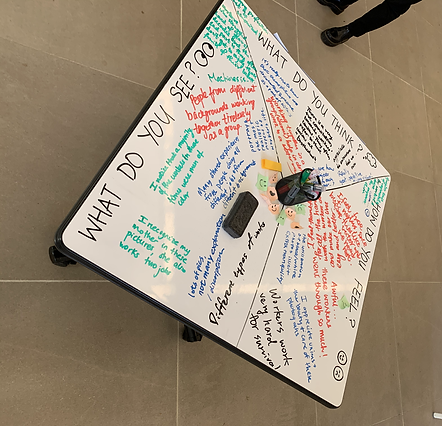
SETUP
We set up our experience prototype in the lobby of UW Allen Library and placed a whiteboard table right beside the existing photography exhibition. We also offered the props, including markers, an eraser, and mockup emoji stickers.
Three questions were written on the whiteboard - What do you see? What do you think? and How do you feel?
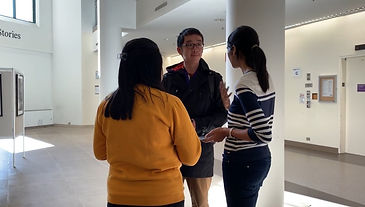

BONUS - ATTRACTED AN UNEXPECTED USER
We invited 7 users to participate and observed how they interacted with the whiteboard. Through this 30 mins testing, we were excited that we attracted a UW student who happened to pass by our experiment. He approached our mockup and directly interacted with it.
Evaluation#2: Feedback from Users
Overall the final idea was successful as most of the testers were able to articulate their learnings after the testing.
-
Feedback on the board helped users organize ideas and thoughts
-
Choice in stickers and emojis are useful
-
Learned more by articulating and revisiting their thoughts about the content and how it relates to them
-
It is fun to build ideas on each other’s thoughts
-
Thought the board helped form their thoughts and exchange them with others
-
Need more writing space and crowd management
-
Questions can be more customized
Learnings and Takeaways.
1.
Find inspiration through rapid ideation process
The rapid ideation process inspired a lot of possibilities for design. Focusing on the quantity first and then narrow down the scope was a helpful approach to come up with design ideas.
2.
Always have a plan b for data collection plan
This is my first time conducting data collection in such short period of time. I learned to use secondary research and leverage backup plans for data collection.
3.
Roll out testing when feeling unsure about the situation
When having a debate around uncertain user behaviors, the most efficient way is to conduct a quick testing and collect user feedback facilitate the decision making process.
4.
If I have more time, I would...
run a longer experiment and test it in different types of museums
